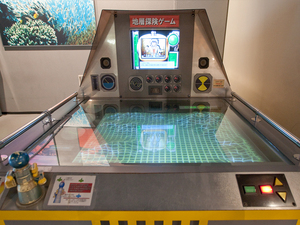Nagoya City Science Museum
TOP > Exhibition Guide > Floor Map> Where are you burying?
Where are you burying?



Purpose of Exhibition
In this game, you will experience a time trip to 300,000 years ago on a mission to bring back a time capsule to the present world safely.
Additional Knowledge
Additional Knowledge:
[Why do fossils remain?]
Probabilities for fossils to remain are very low. Unless organisms were buried in the ground and isolated from oxygen, they would decay. They may be destroyed in the process of being buried underground. They may be destroyed in the course of diastrophism after they were suitably buried underground. Unless they were buried in a place subject to little diastrophism, their probabilities to remain as fossils become considerably low.
[Diastrophism]
The diastrophism that destroys fossils buried underground includes faults and folds.A fault means the gash where the ground or base rock is dislocated along a certain plane. In the case of a large-scale fault, it appears like a belt of broken rocks along a gash, which is called a fault zone, rather than a simple gash. An earthquake is a tremor generated when the ground is dislocated to create a fault. The place where you can find many faults is prone to earthquakes.A fold means a bend in a stratum, where the ground was gradually bent under great pressure in a long time. Although rocks appear to be very hard, they can deform in a long time. If fossils are buried in a stratum, they will be deformed or destroyed.
[Cause of diastrophism]
A mechanism causing a fault or a fold is the motion of plates. The earth's surface is covered with ten-odd plates (base rocks of approx. 100 km thick) adjoining with each other, which are changing their relative positions. In the place where two or more plates are shoving each other, compressing force works on base rocks, which will be cracked or deformed. This is a fault or a fold. In most cases, diastrophism is caused primarily by the motion of plates as explained above.
Coperation: Donated by Adhoc Co., Ltd.
Article by Shoji Nishimoto, curator
